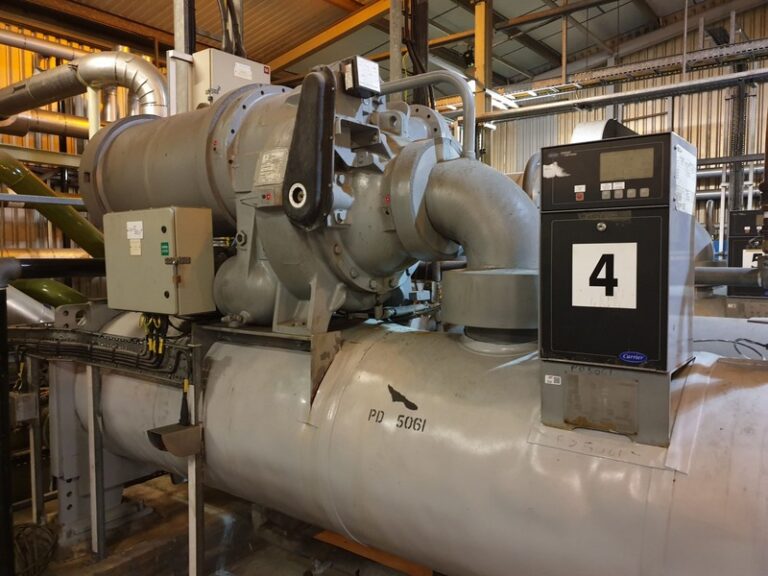The evaporator is where the actual cooling happens — it’s the interface between the process fluid (usually water or a water-glycol mixture) and the refrigerant. As the refrigerant evaporates by absorbing heat from the circulating fluid, the chilled water is then ready to be pumped through various processes like plastic molding machines, pharmaceuticals, food processing lines, HVAC systems, and more.
Depending on the application, system size, and performance requirements, evaporators in air-cooled chillers come in different configurations — from direct expansion coils and brazed plate heat exchangers to flooded shell-and-tube designs. With recent advances in materials, sensor integration, and refrigerant technologies, these evaporators are becoming more intelligent, more efficient, and more application-specific than ever before. Understanding the design, functionality, and operational behavior of evaporators is crucial — not just for mechanical engineers and HVAC professionals, but also for decision-makers who want to ensure long-term energy savings, reliability, and environmental compliance in their cooling systems.
Role and Working Principle
In an air-cooled chiller, the evaporator is the component where heat is absorbed from the process fluid (typically water or glycol solution). It allows the refrigerant to evaporate by absorbing heat from the chilled water, thus lowering the fluid temperature before it’s circulated to the cooling load.
- Basic Flow: Chilled water enters the evaporator, transfers its heat to the refrigerant (commonly R-410A, R-134a), and exits at a much lower temperature. The refrigerant evaporates into vapor during this process.
Types of Evaporators Used in Air-Cooled Chillers
While shell-and-tube evaporators are common in water-cooled chillers, air-cooled chillers often rely on:
- Brazed Plate Evaporators (BPEs): Highly compact and efficient; made by brazing stainless steel plates together, ideal for low-capacity chillers.
- Flooded Type Shell & Tube: Sometimes used in larger systems, ensuring complete immersion of tubes in refrigerant for higher heat transfer.
- Direct Expansion (DX) Coil Evaporators: Common in small to mid-range units where the refrigerant directly absorbs heat from the fluid in the coil.
Unique Insights and Features
Dual Circuit Evaporator Designs
- Many modern air-cooled chillers incorporate dual refrigerant circuits in a single evaporator, enabling redundancy and part-load efficiency. If one circuit fails, the other can continue operation, ensuring uninterrupted cooling.
Anti-Fouling Coatings
- Some chillers now use epoxy or hydrophobic coatings inside evaporators to resist scaling, biofilm, and corrosion — especially beneficial in regions with hard water or chemical-laden process fluids.
Low-GWP Refrigerant Compatibility
- Evaporator designs are evolving to support new refrigerants with low Global Warming Potential (GWP) like R-32, R-1234ze, or R-454B. This involves optimizing internal geometry to match new boiling points and thermal properties.
Smart Sensor Integration
- Advanced chillers integrate embedded pressure, temperature, and flow sensors directly inside or around the evaporator. These enable real-time diagnostics for fouling, subcooling, and refrigerant flow imbalance.
Application-Oriented Customizations
Glycol-Based Systems
- In pharmaceutical and food processing plants, glycol mixtures are used as the secondary fluid. Evaporators must be built with compatible materials like 316L stainless steel to prevent corrosion and ensure hygiene.
Low-Temperature Chilling
- For laser cooling, MRI systems, or ice rinks, the evaporator must be designed for sub-zero output temperatures. This requires precise control to prevent refrigerant slugging and ensure even heat distribution.
Evaporator Efficiency Boosting Strategies
- Variable Refrigerant Flow (VRF) Modulation: In modern chillers, VRF is used to match the refrigerant flow to real-time load changes in the evaporator.
- Microchannel Plate Enhancements: Some manufacturers add micro-turbulent structures inside plate evaporators to disturb laminar flow, increasing turbulence and heat exchange efficiency.
- Defrost Cycle Optimization: In cold environments, evaporators may face freezing issues. Enhanced control systems initiate predictive defrost cycles to protect the evaporator without affecting efficiency.
Maintenance & Monitoring Considerations
- Flow Rate Control: Ensuring the correct chilled water flow rate through the evaporator avoids issues like freezing, superheating, or pressure drop.
- Periodic Descaling: In high-mineral-content water areas, descaling is crucial. Automated descaling systems are becoming common in premium chiller lines.
Future Trends
- AI-Powered Evaporator Control: Predictive algorithms will soon regulate refrigerant injection and load balancing based on evaporator temperature deltas.
- Magnetic Refrigeration Systems: Research is being done into evaporator-less systems using magnetocaloric effects, which could revolutionize how heat is absorbed in chillers.
While the condenser often gets the spotlight in air-cooled chiller systems, the evaporator quietly drives performance, energy savings, and application suitability. From compact brazed plate units to advanced dual-circuit DX designs, modern evaporators are evolving to meet the demands of greener refrigerants, smarter control systems, and specialized cooling needs. For industries aiming to enhance operational efficiency and minimize downtime, investing in the right evaporator design — and maintaining it well — is not just a technical detail; it’s a strategic advantage. As innovation continues, the evaporator will remain central to the future of sustainable, intelligent cooling.

